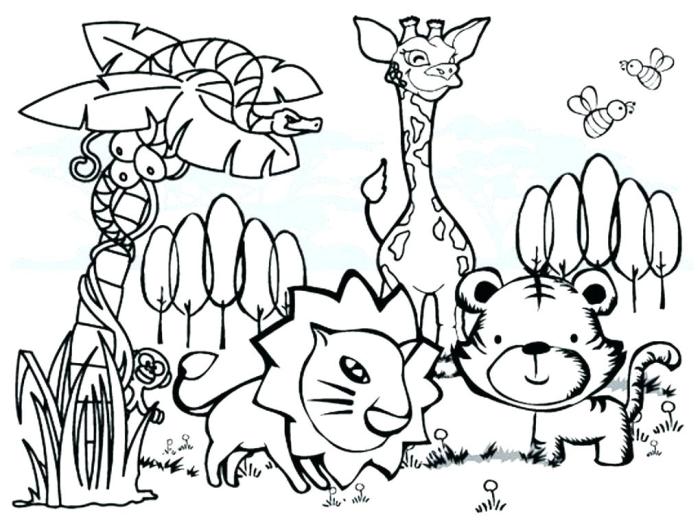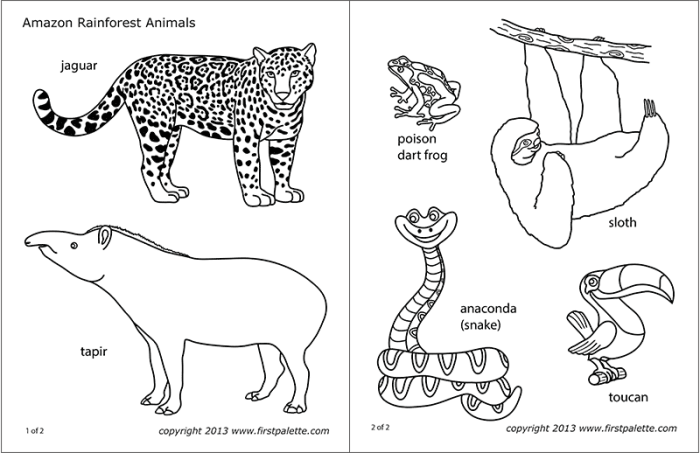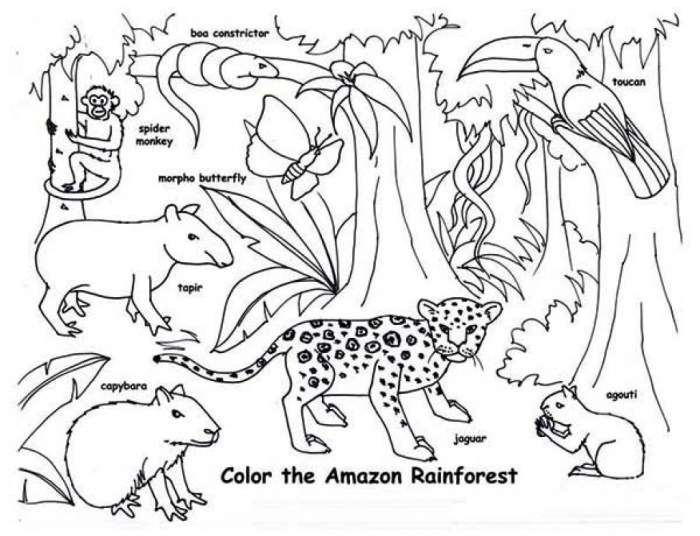Target Audience and User Experience

Coloring pages forest animals – Designing effective forest animal coloring pages requires a clear understanding of the intended users and how to optimize their experience. This involves considering age, interests, and skill levels to create engaging and enjoyable activities. Careful design choices directly impact the overall appeal and usability of the coloring pages.The primary target audience for forest animal coloring pages is children, spanning a wide age range from preschoolers to early elementary schoolers (approximately ages 3-8).
However, depending on the complexity of the designs, the target audience could also include adults who enjoy coloring as a relaxing hobby or therapeutic activity. This broader approach allows for the creation of multiple coloring page sets catering to different skill levels and interests.
Coloring pages featuring forest animals offer a diverse range of subjects, from playful squirrels to majestic owls. For a truly captivating experience, consider adding a touch of the wild with jaguar animal coloring pages ; their striking patterns make them a fantastic addition to any collection. Returning to the broader theme, the beauty of forest animal coloring pages lies in their ability to spark creativity and engage children of all ages.
Target Audience Considerations and Design Choices
The design choices significantly depend on the target audience. For younger children (3-5), simpler designs with bold Artikels and large, easily colored areas are crucial. These designs should feature recognizable and appealing animals, such as rabbits, deer, and bears, with minimal detail. In contrast, coloring pages for older children (6-8) and adults can incorporate more intricate details, smaller spaces, and more complex patterns.
These designs might include realistic depictions of forest animals, showcasing textures and variations in fur or feathers. The color palettes also differ; brighter, bolder colors work better for younger audiences, while more nuanced and sophisticated palettes might appeal to older users. For adult coloring pages, a focus on intricate designs and potentially a calming color palette would be most effective.
Consideration of different skill levels within age groups is also vital.
Improving User Experience of Forest Animal Coloring Pages
Several factors contribute to a positive user experience. High-quality printing is essential; the lines should be crisp and clear, preventing smudging or bleeding. The paper’s thickness is equally important to prevent bleed-through, especially with markers or watercolors. Providing a variety of designs within a single set caters to different preferences and keeps users engaged. Including a variety of animals, from common woodland creatures to less familiar species, adds diversity and educational value.
The addition of simple background elements, such as trees or flowers, can enhance the overall aesthetic appeal. Finally, the inclusion of a small amount of educational information about the animals, such as their habitats or diets, adds an additional layer of engagement and learning.
User Feedback Survey Structure
A well-structured user feedback survey is crucial for gathering valuable insights to improve future designs. The following table Artikels a potential survey structure:
| Question | Response Type | Target Audience | Importance |
|---|---|---|---|
| How easy was it to color the pages? | Rating scale (1-5) | All | High |
| How appealing were the animal designs? | Rating scale (1-5) | All | High |
| Did you find the coloring pages engaging? | Yes/No | All | High |
| What was your favorite animal to color? | Open-ended text | All | Medium |
| What age range is this coloring book best suited for? | Multiple choice (e.g., 3-5, 6-8, 9-12, Adults) | Adults | Medium |
| Were the lines clear and easy to follow? | Yes/No | All | High |
| Would you recommend this coloring book to others? | Yes/No | All | High |
| What suggestions do you have for improvement? | Open-ended text | All | High |
Educational and Therapeutic Aspects

Forest animal coloring pages offer a surprisingly rich blend of educational and therapeutic benefits, extending beyond simple entertainment. They provide a fun and engaging way for children to learn and grow, while simultaneously offering adults a valuable tool for stress relief and relaxation. This multifaceted approach makes them a versatile resource for both educational settings and therapeutic practices.
Coloring engages multiple developmental areas in children. The act of staying within the lines enhances fine motor skills, crucial for handwriting and other dexterity-based tasks. Choosing and applying colors fosters color recognition and understanding of color theory. Furthermore, coloring pages featuring forest animals can introduce children to the diverse wildlife of their environment, stimulating their curiosity about nature and expanding their knowledge of different species.
Fine Motor Skills Development and Color Recognition in Children
Coloring pages provide a low-pressure, enjoyable method for children to practice fine motor skills. The precise movements required to stay within the lines and apply color evenly strengthen hand muscles, improve hand-eye coordination, and contribute to the development of a steady hand—essential skills for writing, drawing, and many other activities. Simultaneously, children learn to identify and differentiate between various colors, expanding their vocabulary and understanding of the visual world.
For instance, a coloring page depicting a red fox and a brown bear helps children differentiate between these colors and associate them with specific animals.
Stress Reduction and Relaxation for Adults, Coloring pages forest animals
The repetitive and focused nature of coloring has a calming effect on the mind. For adults, engaging with coloring pages can serve as a mindful activity, reducing stress and anxiety. The act of concentrating on the task at hand allows for a mental break from daily pressures, promoting relaxation and a sense of accomplishment upon completion. The engaging imagery, such as the peaceful scenes of forest animals, further enhances this therapeutic effect, creating a sense of tranquility and connection with nature.
This is particularly beneficial for individuals experiencing high levels of stress or anxiety. Many studies support this; a simple Google Scholar search on “adult coloring books stress relief” reveals numerous peer-reviewed articles on the topic.
Incorporating Forest Animal Coloring Pages into Educational and Therapeutic Settings
Forest animal coloring pages can be easily integrated into various educational and therapeutic contexts. In classrooms, they can be used as a reward, a quiet activity during downtime, or as a supplement to lessons on animals, nature, or habitats. Therapists can use them as a tool for stress management, mindfulness exercises, or as a starting point for discussions about emotions and self-expression.
For example, a child might color a picture of a calm deer to express feelings of peace, or a more aggressive animal to represent anger.
Educational Elements Incorporated into Forest Animal Coloring Page Designs
To maximize the educational value, coloring page designs can be enhanced with additional elements.
Here are some ways to enhance the educational aspect:
- Include labeling exercises: Add blank spaces next to animals for children to write their names.
- Incorporate simple facts: Include small text boxes with interesting facts about each animal, like their habitat or diet.
- Add a simple maze or puzzle: Integrate a small maze leading to the animal, encouraging problem-solving skills.
- Create a ‘find the…’ activity: Hide small objects within the forest scene for children to locate.
- Use realistic depictions: Employ accurate representations of animal features and habitats to foster accurate understanding.
Illustrations and Imagery: Coloring Pages Forest Animals

Forest animal coloring pages typically feature charming and whimsical depictions of animals in their natural habitats. The imagery often aims to be both engaging for children and aesthetically pleasing for adults. Animals are usually portrayed in friendly, approachable postures, rarely showing aggression or fear. The environments are often simplified representations of forests, featuring lush greenery, towering trees, and perhaps a sunlit clearing.
Accompanying elements might include flowers, mushrooms, butterflies, or other small woodland creatures. The overall style tends towards the cute and cuddly, though some pages may incorporate more realistic details depending on the target age group.
Detailed Descriptions of Forest Animal Coloring Page Illustrations
The visual appeal of coloring pages relies heavily on effective composition, detailed line work, and a well-chosen color scheme. Below are three examples showcasing different approaches.
| Illustration | Description | Composition | Color Scheme |
|---|---|---|---|
| A playful fox peeking from behind a large oak tree | The fox is depicted in a semi-profile view, its head and front paws visible, the rest of its body hidden behind the tree trunk. The tree is detailed with textured bark and leaves. | The composition uses the tree as a framing device, creating a sense of mystery and intrigue. The fox’s playful expression is the focal point. | Earthy tones: browns, greens, oranges, and creams for the fox and tree, with pops of brighter colors for the leaves and background. |
| A family of deer grazing in a sun-dappled meadow | A mother deer and two fawns are shown peacefully grazing. The meadow is filled with wildflowers and tall grasses, with a distant line of trees suggesting depth. | The composition uses a balanced arrangement, with the deer family positioned centrally. The use of perspective and details creates a sense of realism. | Warm, natural colors: various shades of brown for the deer, greens and yellows for the meadow, and a soft blue for the distant sky. |
| A wise old owl perched on a branch, surrounded by nocturnal insects | The owl is depicted in a frontal view, its large eyes and feathery details carefully rendered. Moths and fireflies surround it, adding to the nocturnal setting. | The composition is fairly symmetrical, with the owl as the central element. The insects add visual interest and create a sense of movement. | Darker color scheme: deep greens and browns for the branches and owl, with glowing yellows and blues for the insects. |
Effective Use of Positive and Negative Space
Positive space refers to the areas occupied by the illustration’s elements (the animals, trees, etc.), while negative space is the empty space surrounding them. Effective use of both is crucial for creating a balanced and visually appealing design. For instance, a coloring page featuring a single, large animal against a simple background (lots of negative space) emphasizes the animal’s details and creates a sense of calm.
Conversely, a page with multiple smaller animals interacting within a detailed forest setting (less negative space) conveys a sense of activity and energy. A well-designed page will carefully balance these two aspects to achieve the desired effect, avoiding both overcrowding and emptiness.
FAQ Explained
Where can I find free printable forest animal coloring pages?
Many websites offer free printable forest animal coloring pages. A simple online search should yield numerous results. Be sure to check the terms of use before printing.
Are forest animal coloring pages suitable for toddlers?
Simpler designs with bolder Artikels are best for toddlers. Choose pages with fewer details to avoid frustration. Always supervise young children while coloring.
What kind of paper is best for coloring forest animal pages?
Thicker paper, such as cardstock or watercolor paper, is ideal to prevent bleed-through, especially when using markers or watercolors.
Can I use digital coloring apps with forest animal coloring pages?
Yes! Many digital coloring apps allow you to upload images or use pre-loaded coloring pages, offering a digital alternative to traditional coloring.
